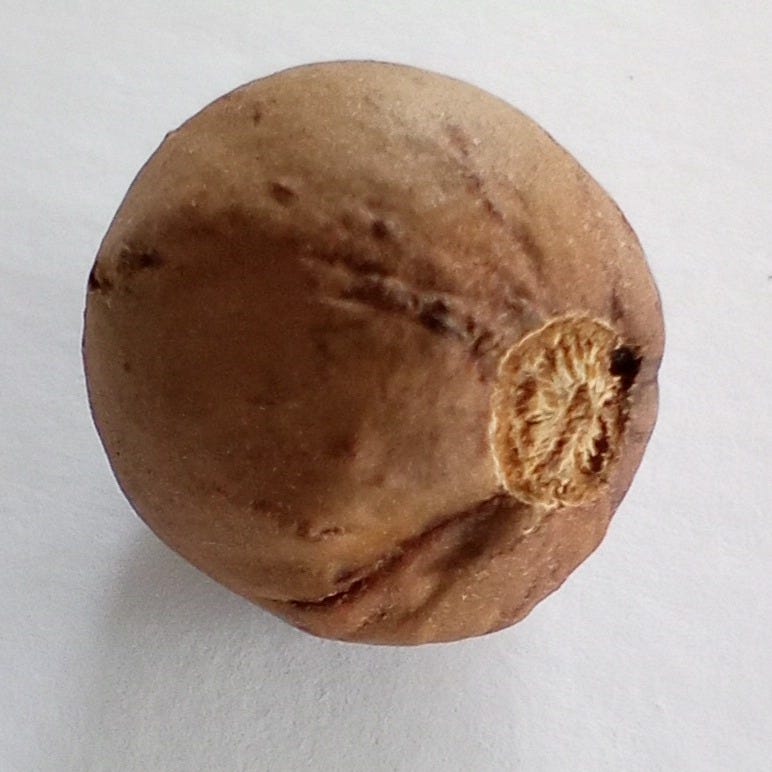Every month I curate a nature diary-style collection of my illustrations and observations of things I’ve noticed and been inspired by in my local environment. Make sure you never miss a post by subscribing to Drawn to Nature for free; and if you are minded to support my work, I’d be grateful if you would consider becoming a paid subscriber.
8th January
One of the first things we did when moving into our house here in Berwick-upon-Tweed was to plant an ‘edible’ hedge along the front of our property. Many of our neighbours have hedges (primarily privet, beech or cropped conifer) but we wanted to create a mixed hedge using native species that would feed both wildlife and ourselves. We therefore have a mix of dog roses, blackthorn, hawthorn, elder, crab apple and hazel, but the only variety that has consistently flowered and fruited to-date is the wild rose (creating tonnes of beautiful fragrant flowers in spring/summer, plus plenty of delicious hips in the autumn/winter - enough for me to harvest for rosehip syrup, whilst still leaving plenty for the birds).
I was therefore very excited to notice that some hazel catkins have appeared this month, meaning it is more likely that we might get some hazelnuts in 2025! The catkins are fat little things at the moment, covered in lots of fluffy hairs and with an obvious diamond-shape pattern but they’ll open in the spring to release lots of yellow pollen. Catkins are the male flower, so I’m keeping my eyes peeled for the tiny red female flowers that need to be pollinated!
12th January
The temperature has plummeted this week and we woke up to thick frosts today - quite unusual for us here on the coast where the warming effect of the sea usually minimises the amount we get (although apparently this is more pronounced on the West Coast of the UK, rather than here in the East).
There is something special about a frosty day in January that often means that I take a bit longer on the morning dog walk to enjoy it.
Did you know that there are four main types of frost: hoar frost, ground frost, air frost and rime? Rime is a rough white ice deposit which is formed of supercooled water droplets freezing onto vertical surfaces (like a window). Air frost occurs when the air temperature falls below freezing, whilst ground frost refers to the formation of ice on the ground, objects or trees. Hoar frost - seen in my photo above - is a type of feathery frost that forms as a result of water vapour in the air coming into contact with solid surfaces that are already below freezing point - at which point 'feathery' ice crystals form and grow. The word ‘hoar’ comes from old English and refers to the appearance of the frost: the way the ice crystals form makes it look like white hair or a beard.
21st January
The weather has been very variable the last week or so, with mild grey days in between bitter cold ones. Although today was another grey day, there was no wind blowing and so it felt like a good time to go on a sketch walk in an attempt to bring my attention to what nature is currently doing in my little patch of North Northumberland.
Here’s my little collection of sightings, including quite a lot of snowdrops pushing up through the leaf litter, some leaves, seed heads and a little smattering of wild life.
The rookery is in our local cemetery and for the past few weeks they’ve been in full-throated, deafening chorus whenever I’ve walked nearby - to the exclusion of any other bird song. Happily, today there was song from many different birds in the cemetery, including groups of goldfinch, blue tits, starlings and sparrows - they all seemed to be concentrated into their own little area. But the rooks were definitely still the loudest!
Here’s a close-up photo of the oak gall that I harvested to bring home with me after sketching it:
There are around 90 gall wasps in Britain and 42 of these are associated with oaks. Oak galls are formed when a type of wasp lays its eggs, causing the tree to create a protective casing around the area of irritation. The benefit of this to the wasp is the creation of a secure habitat where the wasp grub can grow. Each species of wasp induces a gall of a constant shape and form for the purpose of shelter and food. The ones I usually find are oak marble galls - so-called because they look like marbles attached to twigs at the base of leaves.
I mostly get excited about finding these little beauties because (once the wasp has departed!) they are absolutely chock full of the tannins that, when mixed with iron salts, makes a permanent writing and drawing ink. This was actually the primary type of ink used in Europe from the 5th to the 19th century and it is very easy to make your own. I'm planning to do some work with oak gall inks this year, so watch this space!
26th January
Storm Éowyn hit on Friday 24th January and here in Berwick-upon-Tweed we experienced sustained gusts of 80-85mph from about 9am in the morning until 4pm in the afternoon.
Fortunately, unlike Storm Arwen a few years ago, we sustained very little damage and although I’ve noticed a few trees down here and there, it is nothing like the devastation of 2021.
Unfortunately, I think the strong winds on Friday contributed to the poor showing of avian visitors to our garden over the weekend - which happened to coincide with the annual RSPB Big Garden Birdwatch! We obviously had to take our feeders down on the Friday and although they went back up on Saturday once the winds had calmed, there were no visitors until later on Sunday. In previous years we’ve recorded quite a lot of different species in the garden for Big Garden Birdwatch, but this year we had just our brave resident robin and male blackbird, as well as the local gang of jackdaws (I counted five at one point, trying to work out how to get the fat pellets from one of our feeders). I’ve seen plenty of different tits and finches around in the past few weeks, so I’m fairly sure it was the inclement weather conditions keeping them all away. Oh well! Whilst I’ve not much to contribute from the standpoint of citizen science this year, at least I know that I’ll get to enjoy watching the garden birds again as the weather warms and they start to look for more food to fuel mating, nesting and rearing their young.
My 2025 Almanac
I love an almanac and have asked for one for Christmas for a good few years in a row. Almanacs (for those unfamiliar) have been around since the Middle Ages and are seasonal guides to the world around us, usually including things like sunrise/sunset times, moon phases, tide timetables, etc, but modern ones also include a range of additional information like things to see in nature, seasonal recipes, folklore and more.
This year I’ve opted for The Tree Almanac by Dr Gabriel Hemery, a British forest scientist (silvologist) and author. Some of my top take-aways from the January chapter are:
A professional forester can plant 60 trees an hour, but if everyone alive now planted a tree for every year that they’ve been on the earth (for example, by giving money to tree-planting charities as few of us have gardens big enough to accommodate that many trees), we’d quickly be able to reverse the devastating deforestation that humans have been responsible for in the last few thousand years.
Unlike many other conifers, yew trees produce a red, berry-like structure known as an 'aril' rather than a cone to bear its seeds.
And appealing to the historian in me, yew was the wood of choice for the English Longbow that made the English army so devastating in the 14th century. The heartwood resists compression and was used in the belly of the bow, whilst the sapwood resists tension and was therefore used for the back of the bow; the perfect combination of strength and flexibility.
The Fortingall Yew in Perthshire, Scotland, is considered the oldest yew tree in the UK - estimates put it at somewhere between 3,000 and 5,000 years old.









This was an awesome read! Thank you so much. I've learnt a lot (the different types of frost... definitely didn't know that) and I officially want to buy The Tree Almanac.
You've also really helped me out, by telling us all about Oak Galls - I've got a brand new oak tree I've been growing from an acorn - and it's covered in them. I had no idea what they were until now. It's a shame you don't live in Yorkshire, you could have had loads of ink!! I'll be on the lookout for the wasps emerging now. I'm relieved to know that they are mostly harmless to the tree.
Had no idea about oak gall. Very interesting, thanks!